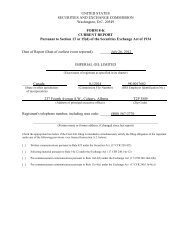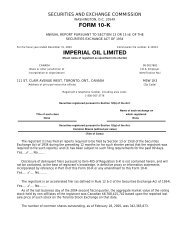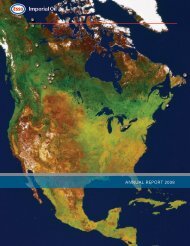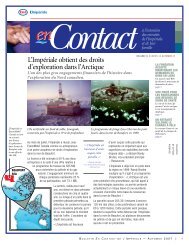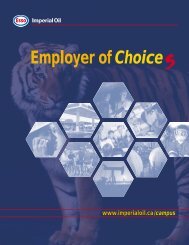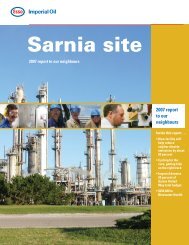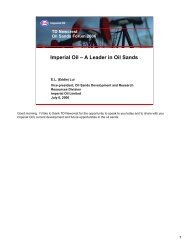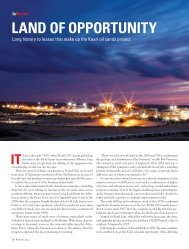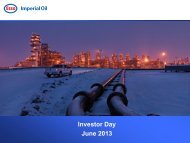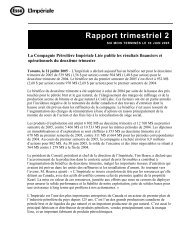Tim Hearn Imperial Oil Overview
Tim Hearn Imperial Oil Overview
Tim Hearn Imperial Oil Overview
You also want an ePaper? Increase the reach of your titles
YUMPU automatically turns print PDFs into web optimized ePapers that Google loves.
<strong>Imperial</strong> <strong>Oil</strong> <strong>Overview</strong><br />
<strong>Tim</strong> <strong>Hearn</strong><br />
Chairman,<br />
president and<br />
chief executive officer
Agenda<br />
T.J. (<strong>Tim</strong>) <strong>Hearn</strong><br />
P.A. (Paul) Smith<br />
B.J. (Brian) Fischer<br />
Break<br />
J.M. (Michael) Yeager<br />
T.J. (<strong>Tim</strong>) <strong>Hearn</strong><br />
<strong>Imperial</strong> <strong>Oil</strong> <strong>Overview</strong><br />
Finance and Administration<br />
Products and Chemicals<br />
15 minutes<br />
Resources<br />
Summary and Questions
<strong>Imperial</strong> is executing a strategy that:<br />
• Continually improves base operations<br />
• Invests in future opportunities<br />
• Increases shareholder value
2004 Year-to-Date Results<br />
$M<br />
1600<br />
1400<br />
1200<br />
1000<br />
800<br />
600<br />
400<br />
200<br />
0<br />
1410<br />
Earnings After Tax<br />
1255<br />
1224<br />
1682<br />
1502<br />
2000 2001 2002 2003 2004<br />
9 mo<br />
• Best-ever safety<br />
performance<br />
• Excellent reliability<br />
• Record third-quarter and<br />
nine-month earnings<br />
• 2000-2004 YTD:<br />
-$6G in capex<br />
-$5G in dividends and<br />
share repurchases<br />
-19% annual<br />
shareholder return
Strong Business Fundamentals<br />
• Petroleum essential to economy and society<br />
• Rising demand<br />
• New supplies required<br />
• Canada uniquely positioned<br />
• <strong>Imperial</strong> <strong>Oil</strong> – assets and resources for<br />
long-term earnings growth
Population Grows 27% by 2030<br />
Russia/<br />
Caspian<br />
North America<br />
Europe<br />
Middle East<br />
China<br />
Japan<br />
Latin America<br />
2003 Population<br />
Level<br />
Africa<br />
India<br />
2003 World Population<br />
6.3 Billion<br />
Other Asia Pacific
Population Grows 27% by 2030<br />
Russia/<br />
Caspian<br />
Middle East<br />
North America<br />
Europe<br />
China<br />
Japan<br />
Latin America<br />
2003 Population Level<br />
2030 Increased Population Africa<br />
India<br />
2030 Decreased Population<br />
Other Asia Pacific<br />
2030 World Population – 8.0 Billion
World GDP Grows by 2.8% Annually<br />
Russia/Caspian<br />
$0.6T<br />
North America<br />
$11.9 T<br />
Europe<br />
$12.2T<br />
Middle East<br />
$0.7T<br />
China<br />
$1.4T<br />
Japan<br />
$4.3T<br />
2003 US$ GDP<br />
Latin<br />
America<br />
$1.8T<br />
Africa<br />
$0.7T<br />
India<br />
$0.6T<br />
Other Asia Pacific<br />
$2.5T<br />
2003 World GDP – US$36.3 Trillion
World GDP Grows by 2.8% Annually<br />
$23.9 T<br />
$20.6T<br />
$1.6T<br />
Russia/Caspian<br />
$7.4T<br />
North America<br />
$4.3T<br />
Europe<br />
Middle East<br />
$1.5T<br />
China<br />
$2.2T<br />
Japan<br />
$5.8T<br />
$6.4T<br />
2003$ GDP Level<br />
Latin<br />
America<br />
2030 Increase in GDP<br />
Africa<br />
$1.6T<br />
India<br />
Other AP<br />
2030 World GDP – US$76.5 Trillion
World Energy Demand By Fuel Grows 1.7%/year<br />
Moeb/d<br />
350<br />
300<br />
250<br />
Solar/Wind<br />
Biomass<br />
Hydro<br />
Nuclear<br />
200<br />
150<br />
Coal<br />
100<br />
Gas<br />
50<br />
<strong>Oil</strong><br />
0<br />
1980 1990 2000 2010 2020 2030
New <strong>Oil</strong> and Gas Supply Required<br />
Moeb/d<br />
180<br />
150<br />
120<br />
90<br />
60<br />
30<br />
0<br />
<strong>Oil</strong> and Gas Supply<br />
Annual<br />
Growth Rate<br />
~2 %<br />
Industry Field<br />
Decline ~ 4 - 6%<br />
Existing Production<br />
Required<br />
New<br />
Production<br />
1985 1995 2005 2015<br />
• Half of supply<br />
required in 2015 is<br />
not yet on stream<br />
• Significant industry<br />
investment required<br />
• Technology and<br />
access critical to<br />
supply growth
Canada’s Distinct and Advantaged Role<br />
<strong>Oil</strong><br />
• Only G-7 country with<br />
hydrocarbon growth potential<br />
• Sound fiscal regime<br />
Gas<br />
• Extensive pipeline<br />
infrastructure<br />
• Secure source of future supply
U.S. <strong>Oil</strong> and Gas Imports - 2003<br />
Moeb/d<br />
4<br />
3<br />
2<br />
1<br />
0<br />
Canada<br />
Saudi Arabia<br />
Mexico<br />
Venezuela<br />
Nigeria<br />
Iraq<br />
UK<br />
Algeria<br />
Angola<br />
Norway<br />
Russia
Large <strong>Oil</strong> Resources Exist<br />
8<br />
<strong>Oil</strong> in Place<br />
Locations of Major Deposits<br />
6<br />
Trillions of Barrels<br />
4<br />
2<br />
0<br />
Produced<br />
Conventional<br />
<strong>Oil</strong><br />
Heavy <strong>Oil</strong>/<br />
<strong>Oil</strong> Sands<br />
<strong>Oil</strong> Shale<br />
• Canada’s <strong>Oil</strong> Sands –<br />
A Major Resource
Current <strong>Oil</strong> Prices<br />
...Reality and Perception<br />
• World not short of hydrocarbons<br />
• Strong world demand for crude oil driven<br />
by economic growth<br />
• Business cycles not eliminated<br />
• Non-OPEC production growing<br />
• Stability of supply – an element of market perception<br />
• Markets adjust
<strong>Imperial</strong> <strong>Oil</strong> Limited<br />
• Largest integrated in Canada<br />
• Market cap: C$25G<br />
• Net proved reserves: 1.84 Goeb<br />
• Upstream production: 340 koeb/d<br />
• Major oil sands producer: 180 kbd<br />
• Leading refiner and marketer<br />
• Chemical sales: > 1.2 MT/year
The <strong>Imperial</strong> <strong>Oil</strong> Advantage<br />
• Consistent management approach<br />
• Continually improving base operations<br />
• Financial strength – ‘AAA’<br />
• Disciplined investment strategy<br />
• Significant proved reserves/resource base<br />
• Technology leader – commitment to research<br />
• ExxonMobil relationship<br />
• Tradition of sound governance
Consistent Management Approach<br />
Disciplined<br />
Investment<br />
• Flawless execution<br />
Superior<br />
Cash Flow<br />
Growth in<br />
Shareholder<br />
Value<br />
Operational<br />
Excellence<br />
• Grow profitable sales<br />
volumes<br />
• Best-in-class cost<br />
structures<br />
Industry<br />
Leading<br />
Returns<br />
• Improve quality of<br />
asset mix
Improving the Base<br />
Proven Management Systems to Improve Base Business<br />
Disciplined<br />
Investment<br />
In-Place Management Systems<br />
Superior<br />
Cash Flow<br />
Growth in<br />
Shareholder<br />
Value<br />
Operational<br />
Excellence<br />
Safety and environment<br />
Production costs<br />
Operations Integrity (OIMS)<br />
Production Operations<br />
Industry<br />
Leading<br />
Returns<br />
Best Practices (POBP)<br />
Maintenance and utilization<br />
Reliability and Maintenance<br />
Energy efficiency<br />
Global Energy Management (GEMS)<br />
Project management<br />
Capital Project Management<br />
Product quality<br />
Product Quality Management<br />
Business controls<br />
Controls Integrity (CIMS)
Safety Leadership – Nobody Gets Hurt<br />
2.5<br />
Employee Total Recordable Injury Rate<br />
2.0<br />
1.5<br />
1.0<br />
Competitors’<br />
Average<br />
0.5<br />
0.0<br />
1983 1993 2003
Improving the Base – Operations<br />
$G<br />
5.0<br />
4.0<br />
3.0<br />
2.0<br />
Normalized Opex<br />
(constant energy)<br />
Opex @ CPI<br />
Index<br />
• Offset $750M inflation<br />
impact 1995-2003<br />
• Upstream mix more<br />
weighted to higher cost<br />
oil sands production<br />
1.0<br />
0.0<br />
1995 2003
Disciplined Investment<br />
Superior Shareholder Distributions<br />
$2.8<br />
Billion<br />
$1.6<br />
Billion<br />
$0.3<br />
Billion<br />
Use of Cash (1999-2003)<br />
Investments<br />
Dividends<br />
Share Repurchases<br />
Debt Repayment<br />
$5.3<br />
Billion<br />
• Funding all quality<br />
opportunities<br />
• Surplus cash directed<br />
to shareholder<br />
distributions<br />
• Dividends increased<br />
10 years in a row
Resource Base an Enabler for Growth<br />
Goeb - 2003<br />
12<br />
10<br />
8<br />
6<br />
4<br />
2<br />
0<br />
2004 Increase<br />
Production<br />
Proved<br />
Reserves<br />
Non-<br />
Proved<br />
Resource<br />
• Largest proved reserves<br />
base in Canada<br />
• Long life reserves<br />
RLI > 16 years<br />
• Non-proved resource<br />
~ 9 billion oil-equivalent<br />
barrels<br />
• 2004 net increase –<br />
oil sands
Technology Leader<br />
%<br />
30<br />
25<br />
20<br />
15<br />
10<br />
Cold Lake -<br />
Demonstrated Recovery<br />
13<br />
17<br />
19<br />
20<br />
25<br />
• Commitment to<br />
proprietary research<br />
• Leading edge oil sands<br />
technology<br />
• Access to ExxonMobil<br />
research and technology<br />
• <strong>Imperial</strong> <strong>Oil</strong> Centre for <strong>Oil</strong><br />
Sands Innovation at<br />
University of Alberta<br />
5<br />
0<br />
1977 1987 1989 1993 1999
Leveraging the ExxonMobil Relationship<br />
Scale/Size Technology Procurement Human Resources<br />
Global centres<br />
of excellence<br />
Proprietary<br />
research -<br />
$1 billion<br />
per year<br />
World-bundled<br />
pricing<br />
Development<br />
and training<br />
• Management systems honed worldwide<br />
• Shared perspectives – best practices transfer
Sustained Increase in Shareholder Value<br />
Ten-Year Cumulative Total Returns<br />
600<br />
500<br />
400<br />
300<br />
S&P/TSX ENERGY<br />
200<br />
S&P/TSX COMPOSITE<br />
100<br />
Source: Bloomberg<br />
0<br />
1993 1994 1995 1996 1997 1998 1999 2000 2001 2002 2003<br />
Value of $100 Invested on December 31, 1993
Sustained Competitive Advantage<br />
Leading Return on Capital Employed<br />
25%<br />
20%<br />
15%<br />
10%<br />
5%<br />
0%<br />
Source: Bloomberg<br />
1999 2000 2001 2002 2003 2004<br />
Five-Year Rolling Average Return on Capital
Agenda<br />
T.J. (<strong>Tim</strong>) <strong>Hearn</strong><br />
P.A. (Paul) Smith<br />
B.J. (Brian) Fischer<br />
Break<br />
J.M. (Michael) Yeager<br />
T.J. (<strong>Tim</strong>) <strong>Hearn</strong><br />
<strong>Imperial</strong> <strong>Oil</strong> <strong>Overview</strong><br />
Finance and Administration<br />
Products and Chemicals<br />
15 minutes<br />
Resources<br />
Summary and Questions



